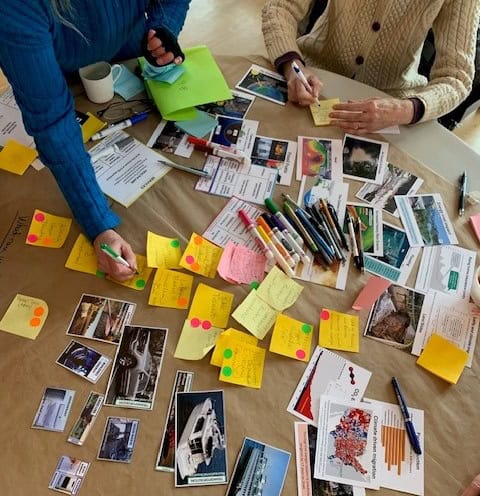Quick Fact: Our Energy Future – Why is OPALCO concerned?
Last month, OPALCO traveled to Olympia to meet with Washington State legislators. Our concern is simple and urgent: U.S. electricity demand is expected to double by 2050. Meanwhile, reliable baseload generation—like coal—is being phased out, with no clear plan to replace it with firm resources. Demand is outpacing supply—and fast.
Our message was direct: when the final 670 MW unit at the Centralia coal plant shuts down at the end of 2025, Washington’s electric grid will become even more vulnerable to rolling blackouts—unless we act now.
We urged lawmakers to support local renewable energy projects in San Juan County by streamlining permitting and providing the funding needed to move them forward.
What we heard in return was disheartening:
“Don’t let an emergency go to waste.”
That’s not leadership. That’s politics.
Back home, some community members have raised concerns about OPALCO’s efforts to explore community solar and tidal energy. But here’s the truth: these are carefully studied, low-impact solutions that are critical to both environmental protection and grid reliability.
While rooftop solar, energy efficiency, and conservation are all valuable, they simply aren’t enough. Rooftop systems generate only a fraction of what we need—especially at night and during our long, dark winters. Efficiency helps reduce demand, but it can’t replace the firm energy lost when coal plants shut down (which OPALCO supports—as long as reliable replacements are in place).
As your local utility, OPALCO is legally required to provide reliable, 24/7 electricity to every member, regardless of how much they use. We can’t just ask people to use less and hope for the best. That’s not how a utility system works.
Starting with cold winter weather events, we predict that the mainland grid will periodically run out of power during times of peak usage. And when that happens, the entire San Juan County will go dark.
OPALCO currently relies almost entirely on hydropower from the Bonneville Power Administration (BPA). But BPA isn’t planning to expand the federal hydro system. That means all new energy load growth in SJC will have to come from other sources.
At night and during the winter, when solar isn’t producing, we must either use expensive energy storage—or import dirtier power, much of it from fossil fuels.
That’s why we are investing in local, utility-scale renewable energy and storage—to ensure a reliable, affordable, and clean energy future for our islands.
Doing nothing is not harmless—it’s dangerous. Scientists warn that if we fail to reduce global carbon emissions, up to one-third of all animal species could face extinction by 2050.
We can’t afford—financially or environmentally—to say “no” to every renewable energy project, locally or regionally, and then wonder why the electricity doesn’t work 24/7.
Picture yourself waking up in your cold, dark home on a winter morning. There’s no power for your coffee, no hot water for your shower—and flashlights and candles aren’t nearly as charming as they once were.
It’s time for our community to decide which trade-offs are acceptable to ensure reliable 24/7 electricity.
OPALCO is committed to being part of the solution—keeping the lights on, protecting our environment, and building a stronger, more resilient energy future for the people of San Juan County.
Background: Washington’s 2026 “Energy Transition” Plan
To evaluate the risks ahead, we used AI (Artificial Intelligence) to model Washington’s current energy trajectory. Here’s a simplified breakdown of the proposed plan to replace the 670 MW of firm baseload generation from the Centralia coal plant:
What’s Happening?
- Centralia coal plant (670 MW) goes offline December 31, 2025.
- In its place:
- 142 MW of solar – intermittent and seasonal.
- 200 MW of 4-hour battery storage – useful for peak demand, but not long-duration power.
- 10 MW of long-duration pilot storage – still experimental, not commercially viable.
That’s a net loss of over 300 MW—and more critically, a loss of firm, dispatchable power our grid depends on.
What Olympia Is Doing—And Why It’s Not Enough
They are:
- Passing clean energy legislation (e.g., CETA, HB 1589).
- Promoting rooftop solar, electrification, and pilot projects.
- Funding low-income assistance and community programs.
They are not:
- Requiring firm replacement generation before scheduled shutdowns.
- Accelerating transmission development at the scale and pace needed.
- Addressing the capacity-duration mismatch between intermittent renewables and 24/7 electricity demand.
- Publishing realistic Loss of Load Probability (LOLP) modeling for 2026.
Do They Know?
Yes. Legislative staff, WUTC analysts, and utility insiders know the risk.
The Northwest Power and Conservation Council (NWPCC) has warned of up to 17% LOLP (Loss of Load Probability) by 2026 without firm resources.
But:
- The warnings are buried in footnotes.
- Politicians don’t campaign on “baseload deficits.”
- Environmental advocacy groups often oppose firm capacity options like gas peakers or advanced nuclear.
Do They Care?
Maybe politically. But operationally? Not enough.
When the blackouts hit—or when utilities are forced to buy expensive emergency fossil-fuel power from spot markets—here’s what we’ll likely hear:
- “Blame climate change.”
- “Blame the utilities for poor planning.”
- “We need more demand response, conservation, and flexible customers.”
But none of that replaces 670 MW of always-on, dispatchable generation.
If this were aviation or drinking water, this level of planning failure would be a national scandal.
In energy policy? It’s labeled “ambition.”
Supporting Links & Sources
Energy Status and Forecasting
Washington state projects electric load will more than double by 2050.
Electricity Demand and Generation
Utility Reliability
Limitations of Rooftop Solar and Efficiency
In California, where the rooftop solar is some of the best, it still only supplies less than 5% of the state’s electricity. Most of the energy comes from utility-scale generation.
In Washington, where solar is much less than California, especially in winter, rooftop solar is currently less than 0.2% of state electricity generation.
Environmental Safety of Tidal and Solar
- U.S. DOE: Marine and Hydrokinetic Environmental Impacts
- NREL: Environmental Benefits of Solar Energy
Extinction Risk from Climate Inaction
The National Academy of Sciences projects that one-third of all plant and animal species will be extinct in the next 50 years.
Global warming is heating Earth’s oceans at the rate of one atomic bomb detonation per second.
- IPBES Global Biodiversity Report (2019)
- WWF Living Planet Report (2022)
- Thomas et al., Nature (2004)
Centralia Coal Plant Shutdown
- TransAlta: Centralia Operations
One 670 MW unit closed in 2020; the second and final unit is scheduled to shut down December 31, 2025.


